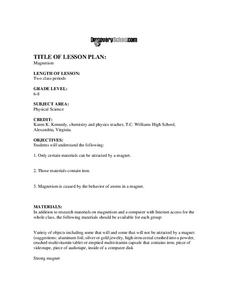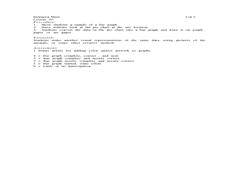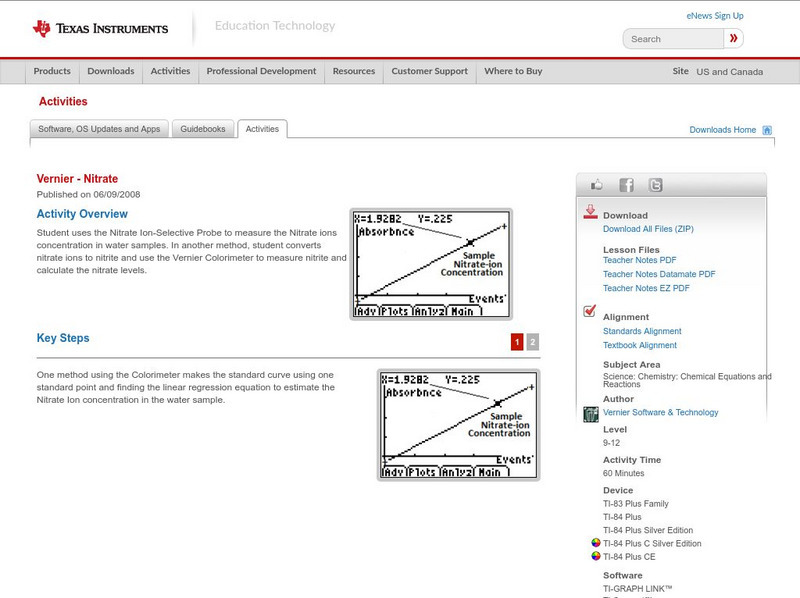Curated OER
Rusting-A Form of Oxidation
Students conduct an experiment to observe oxidation. In this chemistry lesson, students explain how rusting happens. They rank metals according to their conductivity.
Curated OER
Energy in a Cell
In this cell energy worksheet, students are given clues about the light capturing process in plants and the energy producing reactions in animals to complete a crossword puzzle.
Curated OER
Magnetism
Students experiment with the concept of magnetism. Working in small groups, students design an experiment to test the magnet attraction of various substances. After completing their experiments, students research magnetism and it's...
Curated OER
Batteries and Emerging Technology
In this batteries worksheet, students read about how batteries work and the types of batteries. They answer three critical thinking questions about batteries and their use as alternate-fuel sources.
Curated OER
Find the Mystery Lines...If You Can!
In this atomic spectral lines worksheet, students observe a diagram of the spectral lines, their different wavelengths and their intensity. They solve 4 problems which include interpreting the scale, matching up tabulated lines with the...
Curated OER
Logarithmic Functions as Inverses
In this algebra learning exercise, students solve logarithmic functions. They graph their solution using log properties. There are 6 questions.
Curated OER
Rusting-A Form of Oxidation
Students observe the rusting process in the lab. In this chemistry lesson plan, students rank metals according to their conductivity. They give real world applications of this activity.
Curated OER
Physical Equilibrium
In this physical equilibrium worksheet, students compare polar and non-polar compounds and the solubility of specific solutes in solvents. Students calculate molar heat, molar solubility, and molality for specific reactions. This...
Curated OER
Graph a Panther's Diet
Students examine the diet of panthers. In this interpreting data lesson plan, students collect data on the panther's diet and chart the data in bar and pie graphs.
Curated OER
Exploring Magnetism and Electricity
Students explore Faraday's Law. In this electromagnetism lesson, students investigate Michael Faraday. Students discover the history of the electromagnet. Students examine the parts of an electromagnet.
Curated OER
Chemiosmosis- The Mechanism of ATP Synthesis in Chloroplasts
In this chemiosmosis worksheet, students trace the flow of protons and electrons through the thylakoid. Students also explain several key terms including in the reading passage provided.
Curated OER
Rusting: A Form of Oxidation
Students observe and record the corrosive nature of oxidation-reduction reactions, and determine the electro-chemical series of selected metals.
Curated OER
Active Transport
In this active transport worksheet, students review the cellular process of active transport including the structures and functions of the cell organelles involved. This worksheet has 28 fill in the blank statements.
Curated OER
Water Quality And pH
Learners determine the pH level of water and its effect on aquatic plants and brine shrimp eggs. This is a three part instructional activity that leads the student through the development of an understanding of water pH. They form a...
Curated OER
Small Intestine, Pancreas, Liver, and Gall Bladder
In this small intestine, pancreas, liver, and gall bladder learning exercise, students fill in the blanks with information about these structures of digestion. Students research information about organ of the digestive system given.
Sophia Learning
Sophia: Converting Among P H, [H+], P Oh and [Oh ]
This video screencast shows how to convert among pH, [H+], pOH and [OH-], providing several examples. [7:30]
Sophia Learning
Sophia: Converting From Particles to Moles
A guided slide show presentation illustrating how to convert from particles to moles.
Sophia Learning
Sophia: Converting From Grams to Particles: Lesson 2
This lesson demonstrates how to convert from grams to particles (molecules, atoms, ion). It is 2 of 2 in the series titled "Converting from Grams to Particles."
Sophia Learning
Sophia: Converting From Moles to Particles: Lesson 2
This lesson demonstrates how to convert from moles to particles (molecules, atoms, ion). It is 2 of 2 in the series titled "Converting from Moles to Particles."
Texas Instruments
Texas Instruments: Nitrate
Student uses the Nitrate Ion-Selective Probe to measure the Nitrate ions concentration in water samples. In another method, student converts nitrate ions to nitrite and uses the Colorimeter to measure nitrite and calculate the nitrate...
Khan Academy
Khan Academy: The Mole and Avogadro's Number
An explanation the mole (named for molecule) and Avogadro's Number. One mole of a substance is equal to 6.022 times 10 to 23rd power units of that substance (such as atoms, molecules, or ions). The number 6.022 time 10 to 23rd power is...















![Sophia: Converting Among P H, [H+], P Oh and [Oh ] Unit Plan Sophia: Converting Among P H, [H+], P Oh and [Oh ] Unit Plan](https://content.lessonplanet.com/knovation/original/218736-4f79e25d5f5c2bcb250d718e8ac1dcc2.jpg?1661182808)




